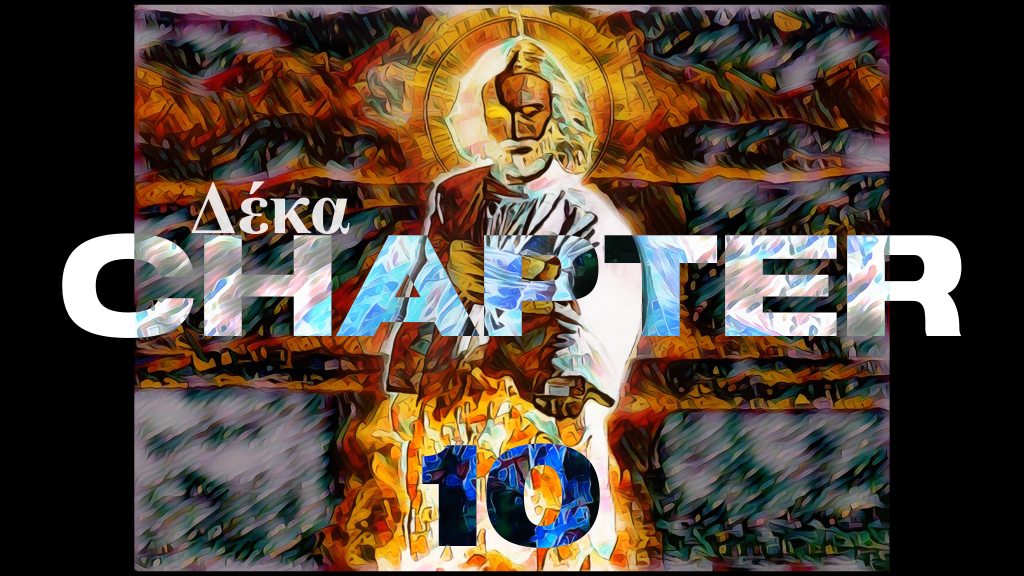

Count the characters. This chapter of Revelation presents listeners with a variety of characters. How many do you count? While some observers say Chapter Ten presents listeners with ten different characters, I see six fewer. No, not ten — only four. One, two, three, four, and no more characters are to be found in Chapter Ten. Of those four, one or two are primary and focal, while the other two are mostly peripheral. You might not agree with me. You might count more. How is it I count only four? Why so few?
John, of course, counts as one character, albeit a relatively minor character. John serves throughout the Book of Revelation as the vision transcriber and as our narrator. For the most part, John quietly and inconspicuously narrates what he sees and hears, and does so whenever possible from the periphery. He does not focus on himself. That is true here in Chapter Ten, except for when he must eat the edible yet indigestible scroll. More on the edible scroll in a forthcoming blog cast.
The Seven Speaking Thunders count as a second character. I say they are a character, as opposed to an event, since they do more than rumble. They speak, and speak intelligibly. Although they are said to number seven, they neither do nor say anything obviously distinctive from each other, but appear to function just as one message bearer. Perhaps they spoke simultaneously in stereo surround sound or echoed the same message in turn; yet nothing in the text indicates that they delivered seven different messages. Again, the Seven Speaking Thunders seem to function narratively as just one character. Furthermore, the Thunders cannot be considered a major character in Chapter Ten, since they appear only briefly in verses 3 and 4, where they deliver a message that is curiously censored, and immediately so.
Forgive me, but to make my point I must resort to Seminary-speak in this paragraph. As I already said, the Seven Speaking Thunders function narratively as one — as a singularity. That fact may be intended to point Revelation’s listeners to an underlying ontological/essential reality: Somehow the Seven Speaking Thunders are best understood as one — a unified one. Ontologically (that is, in essence), they may be just one spiritual entity. Like the Seven Spirits of Revelation 1:4 and 4:5, the Seven Speaking Thunders may constitute not seven separate and distinct individuals, but just one single, yet diverse, entity. Indeed, if Chapter Ten is best interpreted using a Trinitarian hermeneutic, as I would argue it ought to be, then the Seven Speaking Thunders may well be one and the same as the Seven Spirits before the Throne — the one Holy Spirit. I am suggesting that the Seven Speaking Thunders may be the same entity as the Seven Spirits before the Throne, also and more commonly known as the Holy Spirit. Please reference in particular Revelation 4:5, where peals of thunder and seven flaming torches are some of the phenomena associated with the Throne of God.
As for Chapter Ten’s third character, the Mighty Angel stands center stage. And the fourth character, though very, very important, is heard but never seen. That would be the Voice from Heaven. Throughout its eleven verses, Chapter Ten turns John’s attention, and thus the listener’s attention, to these two primary characters, who sometimes act and speak in tandem. Do notice that the Mighty Angel gets most of Chapter Ten’s airtime, by far. Thus the Mighty Angel ought to be considered Chapter Ten’s central character and primary focus.
Now that the four main characters have been counted, I will move on to my next controversial claim. Here it is: The main character is probably not whom you think he is.
Many Revelation-readers/listeners will quickly get the identity of one of these characters right, and just as quickly get identity of the other character wrong. The Voice from Heaven must be God, they will decide, and correctly so. As for the Mighty Angel, he is most likely a high-ranking angel, such as an archangel, many will conclude, incorrectly. Sorry, but that’s the wrong answer, albeit entirely understandable. No, the Mighty Angel is not merely a high-ranking angel. He is mighty. The adjective is there for a reason. He is mightier than other messengers, and far greater than other heavenly emissaries. The Mighty Angel is someone mightier than other messengers, and yet someone other than God Almighty. Who could it be?
Many Revelation interpreters will doubt with my assertions at this point. Some may anticipate where I am going, and disagree with me on this point. They will argue that the Mighty Angel is obviously portrayed as a high-ranking angel. The text clearly says he is an angel, so he must be a heavenly emissary, simply an angel. What else or who else could he be? If not a high-ranking angel or an archangel, what else or who else could the Mighty Angel of Revelation Chapter Ten possibly be?
That is a key question, a crucially important question. Chapter Ten effectively poses that very question to those who are familiar with the Bible. But those who are not well acquainted with Old Testament prophecies will likely make some quick assumptions and even miss the question altogether, because it is implied. The Book of Revelation makes a lot of subtle scriptural references and drops a lot of detailed hints. Key questions and leads are there to be discovered; but they usually require a significant degree of prior biblical knowledge and a substantial measure of theological discernment. The Book of Revelation does this sort of thing very frequently. You gain deeper understanding of the Book of Revelation as you catch the subtle referential hints, which are almost always hidden in plain sight, there in the details. In fact, it may be an accurate statement to claim that no detail whatsoever in the Book of Revelation is extraneous. Every detail given to the listener and provided by the Book of Revelation is there deliberately and intentionally. Such details often require further study. The interpreter will have to reference and re-read Old Testament prophecies. But it will be worthwhile, since the details will help a careful interpreter arrive at a clearer interpretation.
To be blunt, the hints all point to the Mighty Angel being Jesus Christ himself. More specifically, the Mighty Angel is a New Testament cameo of the pre-incarnate, pre-existent Jesus Christ. The Mighty Angel is who Christ Jesus was before he was born as a human being. Throughout the Old Testament, Jesus appears and reappears as a mysterious figure known as the Angel of the Lord. And Revelation Chapter Ten is dropping hints galore that the Mighty Angel is the pre-incarnate Christ. That is indeed the correct interpretation, in spite of how things may initially seem on a superficial, un-referential read.
In particular, two key Old Testament passages are hidden in the details of Revelation Chapter Ten. The first key passage is the opening vision of Ezekiel the exiled priestly-prophet, found in the Book of Ezekiel chapters one and two. The second key passage is the concluding vision of Daniel the exiled statesman-prophet, found in the Book of Daniel chapters ten, eleven, and twelve. If a reader/listener compares Revelation Chapter Ten to the opening chapters of Ezekiel and the closing chapters of Daniel, the detailed references are overwhelmingly obvious.
In both the opening of Ezekiel and the closing of Daniel, a Mysterious Figure appears. Although the Mysterious Figure seems like he might well be God himself, the two passages leave the identity of the Mysterious Figure something of a mystery, because unlike God, he is described as visible and likened in form to a human being, a man. So if he is not exactly God, who is the Mysterious Figure? Is he a variation or manifestation of God, or an angelic proxy, or what? Revelation Chapter Ten points the discerning listener directly to both prophetic passages, and links the Mighty Angel to the Mysterious Figure therein, leaving the distinct impression that the Mighty Angel is one and the same as the Mysterious Figure in both passages.
Therefore, at least three claims can be made. First, the Mysterious Figure in Ezekiel and Daniel is, at very least, God-like in position, appearance, and glory. Second, the Mysterious Figure in Ezekiel and Daniel personally and authoritatively delivers divine messages and interpretations to the respective prophets. Third, Revelation Chapter Ten ties or even fuses these two Mysterious Figures together into one. In Chapter Ten, the equation is not one plus one, but one times one. This is just one individual. The Mysterious Figure in the opening chapters of Ezekiel is one and the same as the Mysterious Figure in the closing chapters of Daniel; that is what Revelation Ten portrays in the person of the Mighty Angel.
So if the Mysterious Figure of Ezekiel, Daniel, and Revelation is the same singular being throughout, who is he? If your inclination is to say that he is an angel of some sort, I would caution you with the observation that he is enthroned in glory among the cherubim in Ezekiel (see also Ezekiel 10:20). Enthroned in glory, like God and as God. Among the cherubim, like the mercy seat of the ark of the covenant, where the presence of God resided. However, if your inclination is to say that he is simply God, I would ask you, How is it that he appears visibly in the likeness of a man in both Ezekiel and Daniel? How is it the prophets can see anyone at all, since God is invisible, and since no one can see God and live (see Exodus 33:20, John 1:18, and 1 Timothy 6:16)?
This individual defies easy categorization because he actually fulfills all three. He is wholly divine. But sometimes he takes the role of a heavenly angel/messenger in order to appear to human beings. But then he went an additional condescending step and even assumed full humanity in the incarnation. He became a man for our sake. Only one individual in history fits all three categorizations: Jesus Christ. Therefore, especially when its two primary Old Testament prophetic references are taken into account, Chapter Ten of Revelation pushes a trinitarian portrait of God, the whole way through. The Voice from Heaven is God the Father. The Seven Speaking Thunders are the Holy Spirit. And the Mighty Angel is Jesus Christ.
But I have not covered everything in Chapter Ten yet. There are two big remaining narrative issues from Chapter Ten that need to be addressed. There is a vow made by the Mighty Angel. And there is an edible scroll given by the Mighty Angel.
Great discussion here, DeKrakenator! I appreciate the image of four characters in this chapter- you did a great job explaining how the seven thunders can be one and the same (the Holy Spirit) and make a solid argument for the mighty angel to be Christ. Up until the end of your post, I was thinking, “Man, this takes some speculation, but what is the point?” Then the Trinitarian image at the end of your post brought it together for me. I can see how this chapter can be understood as a powerful depiction of the Trinity at work, working as one.
LikeLike
Wow,David, I would never had uncovered all this with out your in- depth explanation. I love how the Trinity is present in the OT , the Gospels, and all the way thru Revelation – all connected! Amazing!
LikeLike